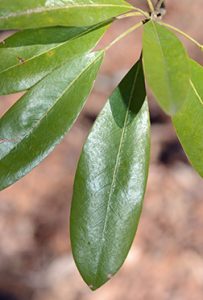Name That Tree
by Ray Novitske, Fairfax Master Gardener
 The answer is the Sweetbay Magnolia (Magnolia virginiana). This tree is at home in lowlands and moist soils, and is often found growing near bodies of water throughout the Atlantic coastal areas from the deep south through to New York’s hardiness zone 5. It can grow up to 35 feet high in our area as a single trunk tree, and taller in warmer climates. In New York and Pennsylvania, it is considered endangered.
The answer is the Sweetbay Magnolia (Magnolia virginiana). This tree is at home in lowlands and moist soils, and is often found growing near bodies of water throughout the Atlantic coastal areas from the deep south through to New York’s hardiness zone 5. It can grow up to 35 feet high in our area as a single trunk tree, and taller in warmer climates. In New York and Pennsylvania, it is considered endangered.
Because of its preference for wet areas, it makes a great tree for rain gardens. It tolerates wet clay soils, but prefers moist soils that are rich in organic material, and likes full sun or partial shade. It can be grown as a single trunk tree, or as a multi-stemmed shrub. Bark is thin and easily damaged by mechanical landscape equipment.
The flowers are 2 to 3 inches in diameter, creamy white and come out in late spring well after the frost danger has passed. The native species has fewer blooms than other magnolias, but its flowers are just as fragrant with a sweet lemony scent. New cultivars such as ‘Moonglow’, ‘Jim Wilson’, and ‘Henry Hicks’ improve on the number of blooms and tolerance to cold.
 Fruits with bright red berries appear in the fall and are attractive to birds and wildlife. Vireos, towhees, Northern flickers, and blue jays all enjoy them. The tree is not bothered by serious pests or diseases, but is susceptible to chlorosis in alkaline soils.
Fruits with bright red berries appear in the fall and are attractive to birds and wildlife. Vireos, towhees, Northern flickers, and blue jays all enjoy them. The tree is not bothered by serious pests or diseases, but is susceptible to chlorosis in alkaline soils.
Leaves are semi-evergreen in our area, but the tree is considered an evergreen in more southern climates. The silvery color on the leaves’ undersides is distinctive in the magnolia family. Leaves also give off a spicy fragrance when crushed.
 The magnolia is one of the most ancient trees still in existence. Because of the tree’s ancient lineage, the flowers do not have true petals and sepals like more recently developed tree species. They instead have petal-like tepals which are outer parts of a flower that are both the petal and sepal. Also, the magnolias do not produce true nectar, but attract pollinating beetles with fragrant sugary secretions.
The magnolia is one of the most ancient trees still in existence. Because of the tree’s ancient lineage, the flowers do not have true petals and sepals like more recently developed tree species. They instead have petal-like tepals which are outer parts of a flower that are both the petal and sepal. Also, the magnolias do not produce true nectar, but attract pollinating beetles with fragrant sugary secretions.
The Houma and Rappahannock native tribes used concoctions of leaves, twigs and bark of Magnolia virginiana to treat colds and chills, to warm the blood and as a hallucinogen. Early colonists referred to magnolias as beavertrees because they used the tree’s fragrant roots as bait when trapping beavers.
Sweetbay magnolias are an under-appreciated tree, but because they are native, have few pests and tolerate a variety of soils, they are good for problem areas and are becoming more popular as specimens in the landscape.
 References
References
Sweetbay Magnolia, Virginia Tech Dendrology
Sweetbay Magnolia, Arbor Day Foundation
Sweetbay Magnolia, Morton Arboretum
Magnolia virginiana, Missouri Botanical Garden
Magnolia virginiana, US Forest Service
Magnolia virginiana, NC State Extension
Sweetbay Magnolia, Chesapeake Bay Program
Magnolia virginiana, Encyclopedia of Life